Musician in the Museum: Display and Power in Neoliberal Popular Culture
Autor Dr. Charles Fairchilden Limba Engleză Paperback – 17 mar 2021
| Toate formatele și edițiile | Preț | Express |
|---|---|---|
| Paperback (1) | 161.76 lei 22-36 zile | |
| Bloomsbury Publishing – 17 mar 2021 | 161.76 lei 22-36 zile | |
| Hardback (1) | 569.29 lei 43-57 zile | |
| Bloomsbury Publishing – 24 feb 2021 | 569.29 lei 43-57 zile |
Preț: 161.76 lei
Preț vechi: 174.65 lei
-7% Nou
Puncte Express: 243
Preț estimativ în valută:
30.96€ • 33.64$ • 26.03£
30.96€ • 33.64$ • 26.03£
Carte disponibilă
Livrare economică 31 martie-14 aprilie
Preluare comenzi: 021 569.72.76
Specificații
ISBN-13: 9781501368899
ISBN-10: 1501368893
Pagini: 272
Dimensiuni: 152 x 229 x 20 mm
Greutate: 0.45 kg
Editura: Bloomsbury Publishing
Colecția Bloomsbury Academic
Locul publicării:New York, United States
ISBN-10: 1501368893
Pagini: 272
Dimensiuni: 152 x 229 x 20 mm
Greutate: 0.45 kg
Editura: Bloomsbury Publishing
Colecția Bloomsbury Academic
Locul publicării:New York, United States
Caracteristici
Explains the larger purpose of pop music institutions as they reflect the changing status of popular music more generally: the steady expansion of popular music museums in the US, UK and Europe over the last two decades is a particularly potent symbol of the larger changes in popular music and culture in the neoliberal era.
Notă biografică
Charles Fairchild is Associate Professor of Popular Music at the University of Sydney, Australia. He is the author of Sound, Screens, Speakers (Bloomsbury, 2019), Danger Mouse's The Grey Album (Bloomsbury, 2014), Music, Radio and the Public Sphere (Palgrave, 2012) and Pop Idols and Pirates (Ashgate, 2008).
Cuprins
IntroductionPart 1: The Place We've Ended Up1. The Democratic [sic] Vistas of Popular Culture2. Neoliberalism's Firmaments of Fame3. Caught Between the Spectacular and the Vernacular Part 2: Ideal Musical Objects4. Popular Music Museums and the Experience Economy5. Preferred Itineraries of Sight, Sound, and Feeling6. Fetish, Effigy, and the Resonant Object Part 3: Ideal Musical Subjects7. The Emergence and Evolution of the Rock Imaginary8. Portraiture and the Currency of Musical Repute9. Displaying 'The Popular'ConclusionBibliography
Recenzii
Charles Fairchild's comprehensive and thought-provoking Musician in the Museum inscribes popular music back into the realm of neo-liberal politics. The book offers a welcome critical intervention on how we think about the contemporary value of popular music and will certainly have considerable effects on academic, journalistic, and vernacular discourses on the heritagization of popular music.
Musician in the Museum shows how proliferating music museums function to reinforce neoliberal ideologies. Charles Fairchild's book usefully adds to the growing literature on music in today's capitalism.
This book contributes to the scarce literature on music and neoliberalism and the criticism of the production and reproduction of social inequalities by exploring popular music museums in cities such as Los Angeles, Liverpool, Seattle and Nashville that have become a crucial part of the Western entertainment industry. In a stimulating way, the book provides important insights into the broader neoliberal restructuring on the social, cultural and economic contexts in which popular culture is situated and shows how popular music museums contribute to the acceleration of these restructuring processes. Thus, the book challenges not only certain established theories for analyzing popular culture but also draws our attention to the well-trodden paths employed by popular music museums to construct white male musicians as "great artists" and audiences as ideal neoliberal subjects. In short, the book guides its readers through a challenging analysis of neoliberalism that goes far beyond popular music museums.
Musician in the Museum shows how proliferating music museums function to reinforce neoliberal ideologies. Charles Fairchild's book usefully adds to the growing literature on music in today's capitalism.
This book contributes to the scarce literature on music and neoliberalism and the criticism of the production and reproduction of social inequalities by exploring popular music museums in cities such as Los Angeles, Liverpool, Seattle and Nashville that have become a crucial part of the Western entertainment industry. In a stimulating way, the book provides important insights into the broader neoliberal restructuring on the social, cultural and economic contexts in which popular culture is situated and shows how popular music museums contribute to the acceleration of these restructuring processes. Thus, the book challenges not only certain established theories for analyzing popular culture but also draws our attention to the well-trodden paths employed by popular music museums to construct white male musicians as "great artists" and audiences as ideal neoliberal subjects. In short, the book guides its readers through a challenging analysis of neoliberalism that goes far beyond popular music museums.
